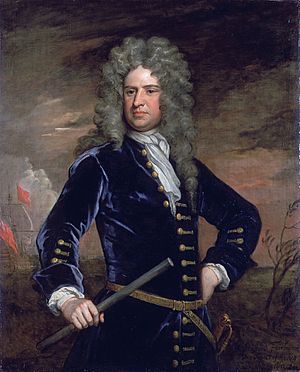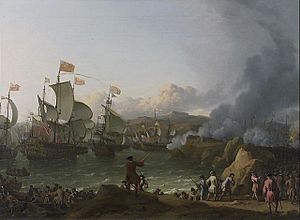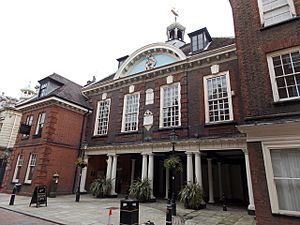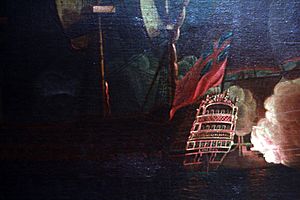Stafford Fairborne facts for kids
Quick facts for kids
Sir Stafford Fairborne
|
|
|---|---|

Admiral Sir Stafford Fairborne by Godfrey Kneller
|
|
| Born | 1666 |
| Died | 11 November 1742 |
| Buried | |
| Allegiance | |
| Service/ |
|
| Years of service | 1681–1715 |
| Rank | Admiral of the Fleet |
| Commands held | HMS Bonaventure HMS Half Moon HMS Richmond HMS Phoenix HMS Warspite HMS Elizabeth HMS Monck HMS Victory HMS Defiance HMS London HMS Albemarle HMS Torbay HMS Suffolk HMS Tilbury |
| Battles/wars | Nine Years' War War of the Spanish Succession |
| Other work | MP for Rochester |
Sir Stafford Fairborne (born 1666, died 1742) was a brave officer in the Royal Navy. He rose to become an Admiral of the Fleet, which is a very high rank. He was also a politician who supported the Whig party.
During his career, Fairborne fought in important battles like the Battle of Beachy Head and the Battle of Barfleur. These battles were part of the Nine Years' War. Later, during the War of the Spanish Succession, he helped win the Battle of Vigo Bay. He also helped capture the city of Barcelona.
Fairborne was a Member of Parliament for Rochester from 1705 to 1710. He also served on the council of the Lord High Admiral, a group that helped manage the navy.
Contents
Stafford Fairborne was the oldest son of Sir Palmes Fairborne, who was the Governor of Tangiers. Stafford started his naval career in 1681. He quickly moved up the ranks.
In 1685, as a lieutenant, he commanded a ship called HMS Bonaventure. He helped win a fight against some ships from Salé. Soon after, he became a commander and took charge of a captured ship called HMS Half Moon.
Fairborne became a captain in 1688. He commanded several ships, including HMS Richmond and HMS Phoenix. He then commanded HMS Warspite at the Battle of Beachy Head in 1690. This was a tough battle where the French navy won.
He also served on land with the Duke of Marlborough during the siege of Cork in Ireland. Later, he commanded HMS Elizabeth at the Battles of Barfleur and La Hogue in 1692. In 1693, he commanded HMS Monck when his fleet was attacked by the French at the Battle of Lagos.
Over the next few years, Fairborne commanded several more important ships. These included HMS Victory, HMS Defiance, HMS London, and HMS Albemarle. In 1700, he sailed to Newfoundland to clear the coast of pirates.
Rising to Senior Command
In 1701, Fairborne was promoted to rear-admiral and was knighted, becoming "Sir Stafford Fairborne." He was given command of a special squadron of ships. His flag was on the ship HMS St George.

His fleet faced a defeat at the Battle of Cádiz in 1702. However, they later achieved a great victory at the Battle of Vigo Bay. After this win, Fairborne helped bring the captured enemy ships safely back to England.
In 1703, Fairborne was promoted to vice-admiral. He became the third-in-command of the Mediterranean Fleet, serving under Sir Cloudesley Shovell. His ship, HMS Association, was caught in the terrible Great Storm of 1703. The storm blew his ship all the way to the coast of the Netherlands, and many sailors were lost. It took a whole month for news of him to reach England.
In 1705, Fairborne was elected as a Member of Parliament for Rochester. He also joined the council of the Lord High Admiral, helping to advise on naval matters.

In 1706, he paid for new pavements outside the Rochester Guildhall, and a stone marking this can still be seen today. He continued his naval duties, leading a squadron to La Rochelle and helping capture Ostend. In these actions, he was known for being very brave and taking on dangerous tasks.
Fairborne became a full admiral in 1708 and then an Admiral of the Fleet later that year. He was re-elected as a Member of Parliament for Rochester. However, he lost his seat in the 1710 election when his political party lost power.
He retired from his council role in 1708. Although he hoped to return to a senior position in the navy, he never did. He lived in London in his retirement. Sir Stafford Fairborne passed away on November 11, 1742, and was buried in Westminster Abbey.
Family Life
Sir Stafford Fairborne was married twice. In 1694, he married Dorothy Fane. They had three sons, but sadly, all of them died before him. They also had one daughter.
After Dorothy passed away, he married Rebecca Paston in 1708. They had one son together. Rebecca also passed away before him in 1724.


